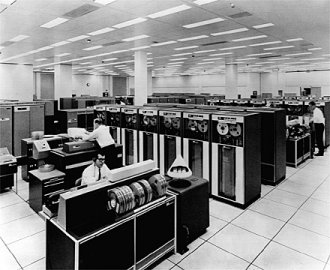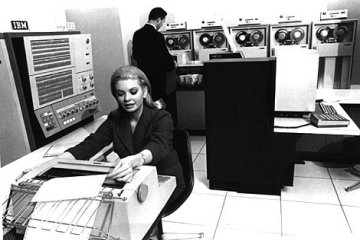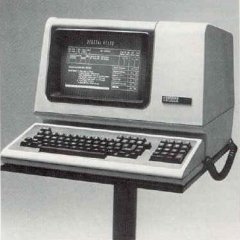| Author: | |
| Website: | |
| Page title: | |
| URL: | |
| Published: | |
| Last revised: | |
| Accessed: |
Many large organisations began using computers for data processing in the 1950s, with the advent of the mainframe computer. Mainframes were both very expensive and very large, occupying entire rooms or even buildings. The mainframe system consisted of a number of cabinets and various items of peripheral hardware. Stricly controlled conditions were required to keep the mainframe running, including a dust-free environment and air-conditioning. The name mainframe comes from the fact that the computer's processing and memory units were housed in a single large cabinet called the main frame.

Mainframe computers occupied a lot of space
Mainframe computers were initially used for batch processing, with batches of jobs being loaded together to run sequentially. The data to be processed was loaded into the mainframe by feeding punched cards into a card reader. The use of magnetic tape, and later magnetic disks, improved efficiency by speeding up data input, but the mainframe's processing unit was still idle for much of the time.

Operators were responsible for input and output
To make more effective use of the mainframe, the concept of multiprogramming was developed. A number of programs could reside in memory at the same time, enabling the mainframe to allocate a small amount of processing time to each job in turn. This required a more sophisticated operating system, and one of the early multiprogramming operating systems was called MULTICS (Multiplexed Information and Computing Service), which enabled processing to be switched from one task to another, as well as introducing a level of interactivity by allowing multiple terminals to have concurrent connections to the host (mainframe) computer.
Computing had evolved from a stand-alone model to a networking model, in which many terminals could access and use the processing power of a computer simultaneously. The first terminals used with mainframes were called dumb terminals because they had no local processing or storage facilities.
The terminal itself was connected directly to the host computer. Input was entered via a keyboard, and output was displayed on a screen. Unix an interactive time-sharing operating system developed towards the end of the 1960s, later became the standard operating system for mainframes and minicomputers, and by 1991 was the most widely used multi-user general-purpose operating system in the world.

A "dumb" terminal
Because of the high cost of mainframe computing, and the fact that computing resources were often at a premium, a department within an organisation that required computing services would need to book a time slot with the IT department, and would be charged for these services on the basis of the computing time used (this is the origin of the term user accounts).
Organisations with spare computing capacity would also sell computing time to other organisations too small to have a mainframe of their own. Remote data processing became possible during the 1960's due to the development of the modem, which enabled remote terminals to connect to the mainframe via the public switched telephone network (PSTN). All of the processing, however, was still carried out by the mainframe.